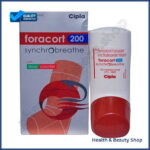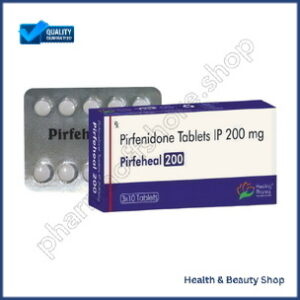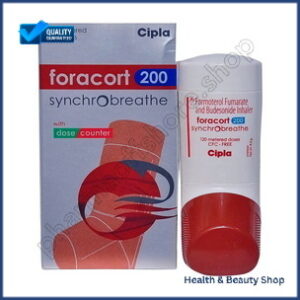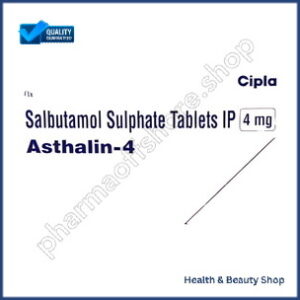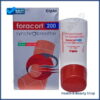Foracort Synchrobreathe Inhaler combines budesonide and formoterol to treat asthma and COPD symptoms. This medication relaxes airway muscles and reduces inflammation, providing relief from asthma symptoms.
To maximize its effectiveness, it’s essential to understand how it works, its benefits, and proper usage techniques. Additionally, it’s crucial to be aware of potential side effects, interactions, and storage guidelines to ensure safe and effective use.
This medication’s dual-action approach helps alleviate asthma symptoms. Budesonide reduces inflammation, while formoterol relaxes airway muscles. When used correctly, Foracort Synchrobreathe Inhaler can provide effective symptom relief.
Proper usage techniques are vital to maximize the medication’s effectiveness. It’s essential to follow the prescribed dosage and administration instructions carefully. Additionally, it’s crucial to monitor side effects and report any concerns to a healthcare professional.
Storage guidelines should also be followed to maintain the medication’s potency. Foracort Synchrobreathe Inhaler should be stored at room temperature, away from direct sunlight and moisture.
By understanding how Foracort Synchrobreathe Inhaler works, its benefits, and proper usage techniques, patients can effectively manage their asthma and COPD symptoms.
Main Points
Foracort Synchrobreathe Inhaler is a combination medication containing formoterol and budesonide, prescribed for managing chronic obstructive pulmonary disease (COPD) and asthma symptoms.
This inhaler provides dual-action relief by relaxing airway muscles and reducing inflammation.
It is prescribed for asthma, COPD, and bronchospasmodic relief, offering quick-relief and long-term control.
Proper inhalation technique is crucial for effective treatment. Regular monitoring of remaining doses is necessary.
The inhaler should be stored at room temperature, away from extreme conditions, to ensure medication quality and potency.
What Is Foracort Synchrobreathe Inhaler
The Foracort Synchrobreathe Inhaler is a prescribed medication that combines formoterol and budesonide to manage chronic obstructive pulmonary disease (COPD) and asthma symptoms.
This inhaler is prescribed by doctors to alleviate breathing difficulties and other respiratory issues. The combination of formoterol and budesonide provides a dual-action approach to managing symptoms.
Formoterol, a long-acting beta2-adrenergic agonist, relaxes airway muscles, making it easier to breathe. Budesonide, a glucocorticosteroid, reduces inflammation in the airways, reducing swelling and constriction that exacerbates respiratory issues.
How It Works in the Body
The Foracort Synchrobreathe Inhaler’s mechanism of action involves reducing inflammation and bronchodilation. Inflammation reduction and bronchodilation are interconnected processes. Understanding how these processes work together helps explain the medication’s benefits and effects.
Mechanism of Action
The active ingredients in Foracort Synchrobreathe Inhaler, formoterol and budesonide, work together to alleviate asthma symptoms.
Formoterol, a long-acting beta2-agonist, binds to beta2-receptors in the airways, relaxing airway muscles. This leads to an increase in airflow and a decrease in symptoms like wheezing and shortness of breath.
Budesonide, a corticosteroid, reduces inflammation in the lungs by suppressing the production of inflammatory chemicals. This helps to reduce swelling and irritation in the airways, making it easier to breathe.
The medication works in the body as follows:
- Formoterol relaxes airway muscles, allowing for easier breathing.
- Budesonide reduces inflammation in the lungs, decreasing swelling and irritation.
- The combination of formoterol and budesonide provides relief from asthma symptoms.
Inflammation Reduction
Budesonide reduces inflammation in the lungs by suppressing the production of pro-inflammatory chemicals. This reduction in inflammation is crucial in managing chronic respiratory diseases such as asthma and chronic obstructive pulmonary disease (COPD).
When inhaled, budesonide binds to specific receptors in the lungs, decreasing the production of pro-inflammatory cytokines and chemokines. These chemical messengers attract immune cells to the site of inflammation, exacerbating the inflammatory response. By reducing their production, budesonide decreases the influx of immune cells, thereby decreasing inflammation in the airways.
As a result, airways become less constricted, allowing for easier breathing and improved lung function. By reducing inflammation, budesonide alleviates symptoms such as coughing, wheezing, and shortness of breath, improving overall quality of life.
Bronchodilation Process
When you inhale Foracort Synchrobreathe Inhaler, formoterol, a long-acting beta2 agonist, binds to beta2 receptors in the airway smooth muscle. This binding triggers a chain of events that relaxes the airway muscles.
The binding causes an increase in cyclic adenosine monophosphate (cAMP), which activates protein kinase A. This enzyme phosphorylates and inactivates myosin light-chain kinase, leading to a decrease in myosin light-chain phosphorylation.
A decrease in myosin light-chain phosphorylation reduces muscle contraction, causing the airway muscles to relax. The relaxation of the airway muscles increases the diameter of the airways, allowing for easier breathing.
Increased airflow into the lungs improves lung function and reduces symptoms of bronchospasm, such as wheezing and shortness of breath. As a result, the airways open up, and breathing becomes easier.
Indications and Usage
The Foracort Synchrobreathe Inhaler is prescribed for specific respiratory conditions, including asthma, chronic obstructive pulmonary disease (COPD), and bronchospasmodic relief. This medication is intended to manage symptoms and improve quality of life.
Asthma Treatment Options
Asthma treatment options vary and are tailored to individual needs. A personalized plan is developed based on symptom severity, medical history, and other factors.
Treatment options for asthma include:
- Quick-relief medications, such as bronchodilators, which relax airway muscles and open up airways to alleviate sudden asthma attacks.
- Long-term control medications, such as inhaled corticosteroids, taken regularly to control symptoms and prevent attacks.
- Combination therapies, which combine quick-relief and long-term control medications for comprehensive asthma management.
Chronic Obstructive Pulmonary
Foracort Sychrobreathe Inhaler is a prescription medication used to treat Chronic Obstructive Pulmonary Disease (COPD). COPD is a progressive lung disease characterized by airflow obstruction, making breathing difficult.
Symptoms of COPD include wheezing, coughing, and shortness of breath, which can make everyday activities challenging. Foracort Synchrobreathe Inhaler is designed to manage COPD symptoms, improving lung function and overall quality of life.
The inhaler contains budesonide, which reduces inflammation, and formoterol, which relaxes airway muscles, allowing for easier breathing. Regular use of the inhaler can lead to fewer symptoms and exacerbations, enabling a more active life. It is essential to follow the doctor’s instructions and take the medication as prescribed to achieve optimal results.
Bronchospasmodic Relief
When experiencing bronchospasmodic attacks, characterized by constricted airways and difficulty breathing, the Foracort Synchrobreathe Inhaler is indicated for relief and management of symptoms. This inhaler is prescribed to manage bronchospasmodic episodes, which can be debilitating and disrupt daily life.
The Foracort Synchrobreathe Inhaler combines budesonide and formoterol, providing quick and sustained relief from bronchospasmodic symptoms.
Key benefits of using the Foracort Synchrobreathe Inhaler for bronchospasmodic relief include:Rapid relief from bronchospasmodic symptoms, allowing easier breathing.Long-lasting relief for up to 12 hours, enabling daily activities.Easy to use, ensuring correct and convenient medication administration.
Dosage and Administration
Dosage and Administration:
The recommended dosage of Foracort Synchrobreathe Inhaler is one inhalation, containing 6-8 micrograms of formoterol and 200 micrograms of budesonide, taken twice daily, in the morning and evening. However, your doctor may adjust this dosage based on your response to the medication.
Before using the inhaler, ensure you understand its correct operation. Rinse your mouth with water after inhaling to minimize the risk of oral thrush. If you’re using other asthma medications, take them as directed by your doctor.
Use the inhaler at the same time every day to maintain a consistent level of medication in your system. If you miss a dose, take it as soon as you remember, unless it’s almost time for your next scheduled dose. Do not take an extra dose to make up for the missed one.
Regularly clean and maintain your inhaler to ensure proper function. If you have any questions or concerns about using Foracort Synchrobreathe Inhaler, consult your doctor or pharmacist for guidance.
Contraindications and Warnings
Contraindications and Warnings
Foracort Synchrobreathe Inhaler is contraindicated in patients with a known hypersensitivity to formoterol or budesonide, or a history of severe hypersensitivity reactions to these medications.
Prescribing caution is advised in the following situations:
- Pregnancy and lactation: The safety of Foracort Synchrobreathe Inhaler during pregnancy and lactation has not been established. A thorough risk-benefit assessment is required before prescribing.
- Cardiovascular disease: Foracort Synchrobreathe Inhaler may increase heart rate and blood pressure, potentially exacerbating existing cardiovascular conditions.
- Diabetes: The inhaler may increase blood glucose levels, necessitating adjustments to the diabetes treatment plan.
It is essential to disclose your medical history and any concerns to your doctor to ensure safe and effective treatment with Foracort Synchrobreathe Inhaler.
Side Effects and Precautions
Foracort Synchrobreathe Inhaler: Side Effects and Precautions
Like all medications, Foracort Synchrobreathe Inhaler can cause side effects. Common side effects include cough, throat irritation, and hoarseness. Headaches, nausea, and vomiting may also occur. Rare but more serious side effects include bronchospasms, allergic reactions, and increased blood sugar levels.
To minimize side effects, use your inhaler correctly and follow the prescribed dosage. Report any side effects to your doctor immediately. Your doctor may adjust your dosage or recommend additional treatment to manage side effects. If you have a history of diabetes, thyroid disorders, or osteoporosis, inform your doctor before starting treatment with Foracort Synchrobreathe Inhaler.
Interactions With Other Medicines
When using Foracort Synchrobreathe Inhaler, consider potential interactions with other medications. Certain drugs can affect Foracort’s efficacy or increase the risk of adverse reactions. Understanding these interactions helps minimize risks and ensures safe and effective treatment.
Drug-Drug Interactions
When taking Foracort Synchrobreathe Inhaler, concurrent use with certain medications can lead to interactions. It is essential to be aware of these interactions to ensure safety and effectiveness.
Concurrent use of Foracort Synchrobreathe Inhaler with the following medications may lead to interactions:
- Beta-blockers: May reduce the inhaler’s effectiveness by counteracting the bronchodilating effects of formoterol.
- Diuretics: May increase the risk of hypokalemia (low potassium levels).
- Tricyclic antidepressants: May increase the risk of cardiovascular adverse effects.
Inform your doctor about all medications you are currently taking to minimize the risk of interactions. With careful planning and coordination, safe and effective use of Foracort Synchrobreathe Inhaler can be ensured.
Adverse Reactions
When using Foracort Synchrobreathe Inhaler with other medications, potential adverse reactions can occur. These interactions can affect treatment outcomes.
Combining Foracort Synchrobreathe Inhaler with certain medications can lead to adverse reactions. The following medications may interact:
| Medication | Adverse Reaction |
|---|---|
| Ketoconazole | Increased risk of systemic corticosteroid adverse effects |
| Ritonavir | Increased risk of systemic corticosteroid adverse effects |
| Itraconazole | Increased risk of systemic corticosteroid adverse effects |
| CYP3A4 inhibitors | Increased risk of systemic corticosteroid adverse effects |
| Beta-blockers | Reduced efficacy of formoterol |
To minimize the risk of adverse reactions, inform your doctor about all medications being taken, including prescription and over-the-counter drugs. Awareness of these potential interactions can ensure safe and effective treatment with Foracort Synchrobreathe Inhaler.
Storage and Handling
Storage and Handling
Store Foracort Synchrobreathe Inhaler at room temperature, between 15?C to 30?C (59?F to 86?F), in its original packaging to protect it from light and moisture. This maintains the quality and potency of the medication.
Keep the inhaler upright and avoid exposing it to extreme temperatures, humidity, or direct sunlight.
Store the inhaler out of reach of children and pets to prevent accidental ingestion or misuse. Do not puncture or incinerate the inhaler, as it contains a pressurized canister. Regularly check the expiration date and dispose of the inhaler properly if it’s past its expiration date or no longer needed.
Patient Education and Counseling
To use the Foracort Synchrobreathe Inhaler correctly, you need training from your healthcare provider. This training should cover proper inhalation techniques, device maintenance, and troubleshooting.
To maximize treatment benefits, your healthcare provider will educate you on the following aspects:
| Aspect | Importance | Guidelines |
|---|---|---|
| Inhalation Technique | Ensures medication reaches lungs | Stand up straight, breathe in deeply through the mouthpiece. |
| Dose Counter | Monitors remaining doses | Regularly check the counter to track your doses. |
| Cleaning | Prevents bacterial growth | Wash the mouthpiece weekly with warm water. |
| Storage | Protects from moisture, heat | Store the inhaler in a cool, dry place. |
Benefits of Combination Therapy
Combining budesonide and formoterol in the Synchrobreathe Inhaler offers a therapeutic advantage. This combination leverages the strengths of both components to provide more effective asthma management.
The benefits of this combination therapy include:
- Enhanced efficacy: The synergistic effect of budesonide and formoterol provides better control over asthma symptoms.
- Convenience: The combination therapy in one inhaler simplifies treatment regimens, reducing the burden of multiple devices and dosing schedules.
- Improved adherence: The Synchrobreathe Inhaler encourages consistent use, leading to better asthma control and reduced risk of exacerbations.
Comparing to Other Inhalers
Comparing Inhalers: Evaluating Treatment Options
When evaluating treatment options, clinicians and patients compare the Foracort Synchrobreathe Inhaler to other inhalers, considering factors such as efficacy, convenience, and patient adherence.
| Inhaler | Dose Frequency | Active Ingredients |
|---|---|---|
| Foracort Synchrobreathe | 2 puffs, 2 times/day | Budesonide/Formoterol |
| Symbicort Turbuhaler | 1-2 puffs, 2 times/day | Budesonide/Formoterol |
| Seretide Accuhaler | 1-2 puffs, 2 times/day | Fluticasone/Salmeterol |
| Breo Ellipta | 1 puff, 1 time/day | Fluticasone/Vilanterol |
| Dulera Inhaler | 1-2 puffs, 2 times/day | Mometasone/Formoterol |
The Foracort Synchrobreathe Inhaler offers a unique combination of budesonide and formoterol. This combination provides effective relief from asthma symptoms and helps prevent future attacks. The inhaler’s Synchrobreathe technology ensures that the medication is released in sync with the user’s breath, making it more effective and convenient to use.
Cost and Availability
The cost of Foracort Synchrobreathe Inhaler varies depending on insurance coverage, pharmacy prices, and location. Research and compare prices at different pharmacies to minimize out-of-pocket expenses. Check with your insurance provider to determine the copayment or coinsurance for the inhaler.
Manufacturer discounts or savings programs may be available. Consider the following options:
- Ask your healthcare provider or pharmacist about potential discounts or coupons.
- Explore patient assistance programs, such as the Foracort Synchrobreathe Savings Program.
- Compare prices at different pharmacies, including online retailers and local pharmacies.
Proper Use and Technique
To use your Foracort Synchrobreathe Inhaler effectively, read and follow the manufacturer’s instruction leaflet and review the device with your healthcare provider or pharmacist. This ensures you understand proper inhaler use and maximize medication benefits.
Before using the inhaler, wash your hands thoroughly. Remove the cap from the mouthpiece and shake the inhaler well for approximately 5 seconds. Hold the inhaler upright and breathe out slowly through your mouth. Place the mouthpiece in your mouth, sealing your lips around it. Inhale slowly and deeply through your mouth while pressing down on the canister. Hold your breath for a few seconds, then breathe out slowly. Repeat the process as prescribed by your doctor.
Correct use of your Foracort Synchrobreathe Inhaler is crucial to maximize medication benefits. If unsure about inhaler use or having questions, ask your healthcare provider or pharmacist for guidance. They can provide personalized instructions and demonstrations to help you master the technique.
Frequently Asked Questions
Can I Use Foracort Synchrobreathe Inhaler With a Spacer Device?
Using a spacer device with your Foracort Synchrobreathe Inhaler can improve medication delivery, particularly if you struggle to coordinate breathing with actuation. This combination can enhance lung deposition and ease of use.
Is Foracort Synchrobreathe Inhaler Safe for Children Under 4 Years Old?
The safety and efficacy of Foracort Synchrobreathe Inhaler in children under 4 years old have not been established. Consult a doctor before administering the inhaler to this age group, as alternative treatments may be more suitable.
Can I Use Foracort Synchrobreathe Inhaler With a Nebulizer Machine?
Foracort Synchrobreathe Inhaler is not compatible with a nebulizer machine. The inhaler is designed for use with metered-dose inhalers, and combining devices can lead to inconsistent dosing and potential adverse effects.
Does Foracort Synchrobreathe Inhaler Contain Gluten or Lactose?
Foracort Synchrobreathe Inhaler is gluten-free but may contain lactose. Consult a doctor or pharmacist for personalized advice on medication allergies or sensitivities.
Can I Travel by Air With Foracort Synchrobreathe Inhaler?
When traveling by air with a Foracort Synchrobreathe Inhaler, prepare for security checks by packing it in your carry-on luggage. Declare the inhaler at security checkpoints and be prepared to show the prescription label or a doctor’s note.
Conclusion
Foracort Synchrobreathe Inhaler is a combination therapy of budesonide and formoterol. It is used to manage asthma and COPD symptoms. The inhaler should be used at the prescribed dosage and with proper technique. Consult a doctor if you have questions or concerns. Foracort Synchrobreathe Inhaler has been proven to be effective and is a convenient option for respiratory care.



